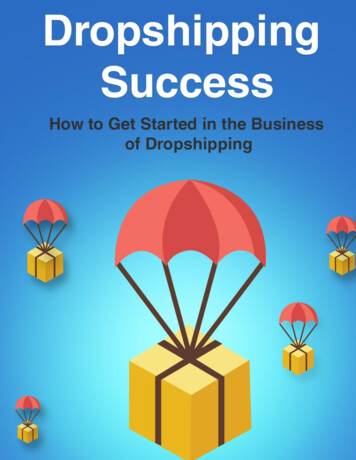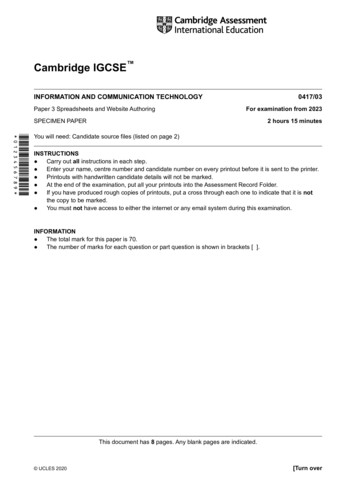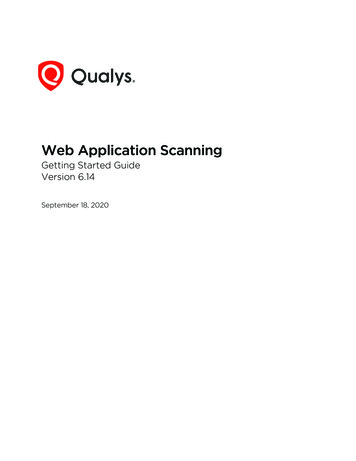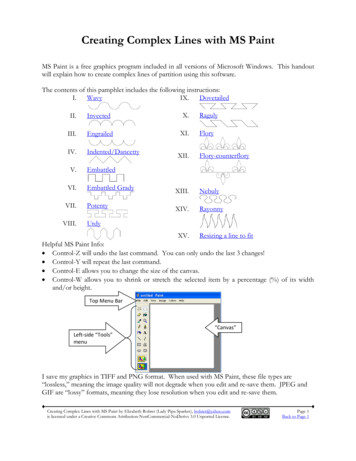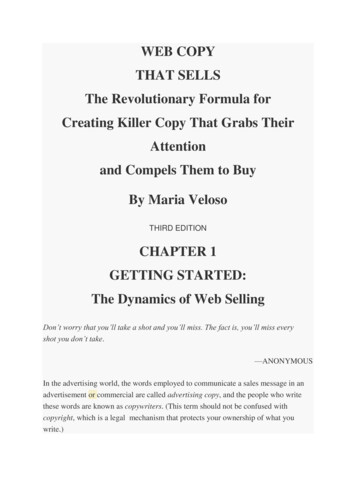
Transcription
WEB COPYTHAT SELLSThe Revolutionary Formula forCreating Killer Copy That Grabs TheirAttentionand Compels Them to BuyBy Maria VelosoTHIRD EDITIONCHAPTER 1GETTING STARTED:The Dynamics of Web SellingDon’t worry that you’ll take a shot and you’ll miss. The fact is, you’ll miss everyshot you don’t take.—ANONYMOUSIn the advertising world, the words employed to communicate a sales message in anadvertisement or commercial are called advertising copy, and the people who writethese words are known as copywriters. (This term should not be confused withcopyright, which is a legal mechanism that protects your ownership of what youwrite.)
Similarly, web copy refers to the words employed to communicate a sales message onthe web, and the people who write these words are web copywriters. Althoughdistinctly different in tone from advertising copy, web copy has the same objectives—that is, to generate leads, customers, sales, and, consequently, profits for a website.(Web copy also should not be confused with web content, which consists of wordswritten for the web for the purpose of informing, communicating, entertaining, oredifying the reader, not necessarily communicating a sales or marketing message.)Web copywriting is one of the most exciting crafts and professions I know of. I oftenequate it with alchemy, but whereas alchemy is the science that turns base metals intogold, web copywriting turns words into money seemingly out of thin air. Think aboutit. The Internet is the only place where anyone can truly market every day for little orno money and have the chance at making a fortune. Personally, I have seen manycompanies and entrepreneurs do it—even on a shoestring budget.Whatever yourwriting skills are, don’t worry! Practically anyone with moderate to good writingskills can learn how to write web copy. One of the best copywriters in the offlineworld, Joe Sugarman, almost flunked English in high school. One of his copywritingstudents, a grapefruit farmer who had never written sales copy, made millions ofdollars over the years using sales copy he wrote to sell grapefruit by mail.Before anydiscussion of web copywriting is attempted, it is necessary to consider a few facts andfigures about the web in order to have a clear concept of the online marketingenvironment in which one needs to operate. As of May 2012, there were approximately 662.9 million (662,959,946) websites (accordingto a Netcraft Web Server Survey)! That’s a 378 percent increase over the 175.4 millionwebsites that existed in 2008. The average Internet surfer who uses a search engine visits 25 websites among the displayedsearch results in three to four minutes. Therefore, the average duration of stay on eachwebsite is approximately eight seconds, including the click and load time. An estimated 107 trillion pieces of e-mail were sent out in 2010 (approximately 294 billione-mails a day—and growing). An estimated 89 percent of these are automated spam mails.Why would the staggering number of websites and e-mails be of any concern to youwhen doing business on the web—especially since all those other websites are notnecessarily your competitors? Here’s why: On the Internet, you’re competing for apiece of the Internet surfers’ online time, and you’re also competing for mind share. In
a cyberuniverse characterized by information overwhelm, every company, individual,or entity that has any kind of Internet presence com-2petes for your prospects’ online time and mind share and is therefore your competitor,for all intents and purposes.With the aforementioned facts in mind, we can now lay the foundation forcommunicating successfully on the web.THREE FUNDAMENTAL RULES FOR WRITINGWEB COPY THAT SELLSIt amuses me that whenever I run a successful campaign with great web copy, I find afew dozen copycats mimicking certain parts of my work. Invariably, however, theymerely copy the words but fail to duplicate the strategy or tactic behind the words,which is what really makes the copy effective. The writing strategy I employ in everyweb copy piece that I write is founded on three relatively simple rules.Rule 1: Don’t Make Your Website Look Like an AdDepending on which source you believe, the average person is exposed to anywherebetween 1,500 (Media Literacy Report published by UNICEF) and 5,000 (CharlesPappas, Yahoo! Internet Life columnist) advertising messages per day from TV,billboards, radio, the Internet, and practically everywhere we turn. That’s an averageof 3,250 advertisements per day.“It’s a non-stop blitz of advertising messages,” Jay Walker- Smith, president of themarketing firm Yankelovich, told CBS News recently. He estimates that we’ve gonefrom being exposed to about 500 ads a day back in the 1970s to as many as 5,000 aday today.
Therefore, the last thing we want to see when we land on a website is yet another ad.Additionally, since most of us have been inundated with ads for most of our lives, wehave developed instinctive mechanisms to tune out commercial messages.Yet many online businesses seem to go out of their way to make their websites looklike ads, billboards, or other commercial media. Don’t fall into this trap, because ifyou do, you’ll turn away potential customers. Always remember that consumers don’thate advertising—it’s bad advertising that they detest. It stands to reason, then, thatyour website should engage your prospects, it should-3provide the solid information that they are looking for, and whenever possible itshould have an editorial feel to it. Above all, it should be free of hype. Why? Becausepeople usually go online to find information. Few people log on saying, “I can’t waitto see ads, and I can’t wait to buy stuff!” No, that usually doesn’t happen.People go online to find information. That’s why they call it the informationsuperhighway. Even if they are shopping for something—say, a DVD player or anantiaging skin care product—they are generally seeking information, not advertising,about those products. There is a myth that the Internet is an advertising medium or onebig shopping channel. It’s not.Here’s the first distinction between offline advertising copy and effective web copy.Web copy needs to provide good information that appeals to the target audience; thatis, ideally, it must not look or feel like a sales pitch.Editorial-Style Web HeadlinesDon’t Buy a DVD Player Unless It Meets These 5 CriteriaHow a Simple Formula Has Been Scientifically Proven to Cure Cancerand Virtually All Diseases[Courtesy of 1MinuteCure.com]
How to Sell Your Home Fast at Top Dollar— Even in aSoft Real Estate Market“Topical Botox”: The New Way to Erase the Look of Wrinkles and Linesfrom Your Skin— Without Injections[Courtesy of TransformationAntiAgingCream.com]Can Streaming Audio Really Double Your Website Sales?A recent Internet research study says you can.What You Don’t Know About Foreclosure CouldCost You Much More Than Just Your Home[Courtesy of SurviveYourForeclosure.com]-411 New Breakthrough Cures That Transform YourHealth and Well- Being— and Add Years to Your LifeNot All Miracle Cures Are Created EqualHow to Tell if a So- Called “Miracle Cure” is ScientificallyProven— or Utter FalsehoodNow You Can Separate Healing Facts from MythsAn Amazing Little- Known FDA- Approved Therapy for Pain Relief,Smoking Cessation, Weight Loss and the Healing of 350 Diseases[Courtesy of ScienceOfAuriculotherapy.com]The World’s Richest Source of Cash— and How You Can Tap Into Itto Start or Grow Your BusinessMelt Away Cancer From Your BodyUsing Nothing More Than Your Fingertips?
Where does the selling come in? It comes from expertly crafted copy that tilts thewebsite visitor’s favor toward your product or service. In other words, avoid blatantsales pitches; instead, provide irresistible information that slides smoothly into a salespitch for your product.Why? Because people online do not want to be sold to. A study conducted by webusability experts John Morkes and Jakob Nielsen (reported in a paper titled Concise,Scannable and Objective: How to Write for the Web) showed that web users “detestanything that seems like marketing fluff or overly hyped language (‘marketese’) andprefer factual information.” If web visitors ever do get sold on something, they wantto be engaged and finessed, not bombarded by blatant advertising.The operative principle here is engagement. Just as a high engagement level—not justthe number of likes—is an important indicator of a healthy Facebook page, so toomust a website have a high engagement score.It bears repeating that your sales pitch should not sound like an ad, but rather it shouldread like an editorial, testimonial, advice, case study, or endorse-5ment. If you want an example of this kind of writing in the brick-and-mortar world,think advertorial (editorial-style ads) or press release. In the offline world, editorialstyle ads boost readership significantly over standard-looking ads. David Ogilvy,legendary advertising man, wrote in his book Ogilvy on Advertising(John Wiley &Sons, 1983), “There is no law which says that advertisements have to look likeadvertisements. If you make them look like editorial pages, you will attract morereaders. Roughly six times as many people read the average article as the averageadvertisement [emphasis mine]. Very few advertisements are read by more than onereader in twenty.” In fact, in a split-run test conducted in Reader’s Digest, aneditorial-style ad boosted response by 80 percent over the standard ad layout.Naturally, not every website can employ the editorial-style approach to webcopywriting. It may not be feasible for catalog-style websites, for instance, to useeditorial articles for each one of their products, especially if they carry hundreds of
products. However, the informational guideline can still be adapted when craftingheadlines and catalog descriptions. Here are a few examples:A year of exposure to the sun is like a weekat the beach without sunscreen.(This editorial- style headline was used by a skin care company toadvertise a product that provides sun protection.)Replacing Sour Cream and Mayonnaise in Your CreamyDressing and Dip Recipes Cuts Down as Much as 1800Calories. But You Can’t Do That With Just Any Yogurt.(This editorial- style headline was used by a yogurt company.)Losing One Pound of Weight Takes 4 Poundsof Pressure Off Your Knees.(This headline was used by the makers of a pain relief medicine.)Notice that in each of the preceding examples the headline provides information thatis not only interesting but also speaks to the needs of the product’s target-6audience. An interesting phenomenon happens when you give information that isuseful to your prospects. They are likely to feel, at the subconscious level, that inorder to get the benefit alluded to in the headline (i.e., protection from the sun, weightloss, or pain relief), only your product will do the job. The yogurt company broughtthat idea home with the line “But You Can’t Do That With Just Any Yogurt”;however, the other two conveyed the same idea.When I worked as the director of creative web writing at Aesop MarketingCorporation, Mark Joyner commissioned extensive in-house marketing research to testthe effectiveness of every imaginable element of our web copy and other onlinemarketing communications. To give you an idea of the magnitude of the research,Aesop’s database consisted of millions of Internet entrepreneurs, and we frequently
tested copy elements on samples of 20,000 names for each testing variable. The salesresults I witnessed at Aesop made clear to me the effectiveness of the editorial style ofcopywriting. In the tests in which I’ve been involved, editorial-style web copyoutpulled sales letter–style web copy every single time. Remember, people generallytune out ads, but they tune in to editorial information. (See Figure 1.1.)Rule 2: Stop Readers Dead in Their TracksOnline business owners spend a lot of time and money trying to get traffic to theirwebsites. Building web traffic is very important, but it won’t mean a thing unless youdo one thing first. That is, create compelling web copy that will stop them dead intheir tracks and get them to do what you want them to do when they get there.Back in April 2004, when the first edition of this book went to press, Google had 36million webpages indexed, and as of July 2008, just four years later, that number hadmultiplied by a factor of almost five, to 175.4 million webpages. At the time of thiswriting, now for the third edition, in May 2012, Google had 56.5 billion webpages—yes, that’s billion, not million—all clamoring for attention! It’s no wonder, then, thatin order for words to wield their magical power on the web, they have to be tailoredspecifically for the information-flooded Internet public, among whom attention span isa rare commodity.-7-
FIGURE 1.1 Editorial- style web copy.FACT: If your website is little more than an online brochure, it’s notonly a very weak selling tool, but it has very little chance of sellinganything in the crowded Internet marketplace. (See Figure 1.2.)The home page of 1MinuteCure.com is a good example of a website that stops visitorsdead in their tracks. The headline incites curiosity (“How a Simple Formula Has BeenScientifically Proven to Cure Cancer and Virtually All Diseases”), and thesubheadline (“Why this one-minute therapy is being suppressed in the U.S. whilemore than 15,000 European doctors have been using it to heal-8-
FIGURE 1.2 Attention- grabbing website.millions of patients”) injects emotion, drama, and credibility. Its copy, written in theeditorial style, follows through by giving readers a sense that they’re reading a newsitem, not an advertisement.Rule 3: Capture E-Mail AddressesFor a website to succeed, it must have effective direct-response web copy that inducesaction from a single exposure. Just think: What’s the point in getting someone to cometo your website if the site visit doesn’t generate a response such as picking up thephone and calling your business, subscribing to your newsletter, signing up for yourmailing list, or buying your product or service?-9Generating a response means more than impressing web visitors with cool graphics ortechnology or getting them to bookmark your site. What’s the point in having cuttingedge web design, eye-popping graphics, and a sophisticated e-commerce
infrastructure if you are unable to entice your visitors long enough for them to do whatyou want them to do?If you are selling something on your website, chances are that less than 5 percent ofyour site’s visitors will ever buy your product. Conversion rates vary with eachindustry, but the typical healthy rate for online stores is 0.5 percent (.005) to 1.5percent (.015), according to the Bock Newsletter on Yahoo! Store (issue 32).“Conversion rates of 2 percent to 5 percent are fairly typical today,” according to areport entitled Getting Clicks with Casual Customers at CNET News. Even the bestmarketers with the most successful websites seldom convert more than 5 percent oftheir web visitors into customers.What happens to the 95 percent of your web visitors who came and went? For mostwebsites, nothing. Those prospects are gone for good, never to return. That’s why it isabsolutely essential for your website to have an opt-in mechanism. The chances areslim that people will buy from you the first time they visit your website. After all, theydon’t even know you. Rather than lose them, ask for something that is easier and lessintimidating than pulling out a credit card—ask them to give you their e-mail address.It’s a simple, nonthreatening way to initiate a relationship.Trust, as we all know, is an important issue in e-commerce, and finding ways to buildtrust in an online environment is a continuing challenge for Internet businesses. On theweb, people buy from people they like and trust. They like people who provide themwith information they need, who are not overly aggressive in trying to market theirproducts, and who are easy to do business with. They trust people who deliver on thepromises they make, who take time to develop a relationship with them, who providegood customer service, and who have an articulated privacy policy to which theystrictly adhere. Capturing contact information is the first step in developing rapportwith prospective customers and in building a relationship that fosters online sales—now and in the future. (See Figure 1.3.)An opt-in offer, such as “How to Pay Less ,” is one way to capture a visitor’s e-mailaddress. (See Chapter 3 for a complete discussion of opt-in mecha-10-
FIGURE 1.3 Exit pop- up opt- in offer.nisms, and Chapter 10 for crafting online campaigns that send your opt-ins throughthe perfect customer life cycle.)THE FIRST LOOKWhat is the most important element of a website? The first screen (or the first eyeful)is the prime selling space of your website, and what you put in it makes or breaks itssuccess. Do not confuse the first screen with the first page, which is often referred toas the home page or the landing page of a website. The first screen is only part of the
page that appears on the screen when you land on a website; it’s the screen you seebefore you scroll down or sideways. In a print newspaper, its counterpart is theinformation above the fold, which draws maximum readership.-11Often, the first screen is the first, last, and only thing people see on a website beforethey click away. For this reason, don’t make the mistake many companies do ofputting a large logo or your company name in gigantic letters on that screen. Somecompanies do this for branding purposes, but in most cases the company name andlogo don’t have to take up half of the first screen. Your logo doesn’t need to belarge—it’s not a selling feature. While it may stroke your ego, it won’t increase yoursales. An oversized logo wastes valuable space, which you could use to engage yourprospects or put them in a frame of mind that makes them ready to purchase from you.A headline must be included in the first screen. It is the most important component ofa webpage. Consider how pointless it would be for a newspaper to have no headline.A website without a headline is just as pointless, yet it’s remarkable how manywebsites fail to put a headline in this prime selling space.In my years of surfing the web, I’ve observed that the majority of commercialwebsites that do have headlines have weak, uninteresting ones, and, as a result, theyare missing a critical opportunity to attract and retain website visitors.When I wrote the copy for 1MinuteCure.com, I used the headline “How a SimpleFormula Has Been Scientifically Proven to Cure Cancer and Virtually All Diseases,”followed by the subheadline “Why this one-minute therapy is being suppressed in theU.S. while more than 15,000 European doctors have been using it to heal millions ofpatients.” (See Figure 1.4.) This headline calls out to a target audience: those who areinterested in discovering a cure for cancer. A headline that calls out to a specific targetaudience—and utilizes a specific angle—is one way to capture the attention of theweb visitor effectively. Contrariwise, when you call out to everyone—or use an anglethat is too broad—you often call out to no one.Case in point: It is interesting to note that the original headline that I wrote for theproduct in question was as follows: “How a Simple Formula Has Been Scientifically
Proven to Cure Virtually All Diseases.” Notice that the headline calls out to a wideaudience and does not specifically name cancer as one of the diseases that can becured. That original headline generated only lukewarm interest. It was only when Iutilized specificity and employed the cancer angle that the headline riveted the mostattention. In fact, just by inserting three words (“Cure Cancer and”), the revisedheadline outpulled the original one by a factor of seven.-12-FIGURE 1.4 Targeted headline captures attention.With regard to the body copy, I began with a series of questions:What if you lived in a world where cancer—or any other disease—was nolonger a threat to you?What if you never had to experience the horror of receiving a doctor’s chilling diagnosis of a terrible disease—or watch helplessly as someone you careabout suffers from cancer or some other life-threatening disease—with younot being able to do anything about it?
Questions are a powerful way to engage your prospects or readers. That’s becausewhenever you ask a question, the brain is compelled to answer it. Readers-13are more likely to believe an idea that their brain seems to have come up with on itsown than an idea that is presented from outside.Never underestimate the power ofyour reader’s imagination. Compare the impact of the following two examples (one aquestion and one a statement) that I tested on my website,WebCopywritingUniversity.com:1. What if there was a way you could convert 15 percent, 25 percent—even 50 percent ormore—of your website visitors into customers; how much more money would you earn asa result?2. Your business can convert 15 percent, 25 percent—even 50 percent or more—of yourwebsite visitors into customers and earn a lot of money.Notice that the statement makes a claim that a reader may or may not believe. Contrastthat with the question, which introduces the possibility of an ideal scenario and allowsthe brain to draw its own conclusions and paint its own pictures.I like to use “What if ” questions or “Imagine what would happen if ” or “Thinkback ” That way, you let your readers envision the scene for themselves. Accordingto Robert Collier, publisher and author of several books, most notable of which is TheRobert Collier Letter Book (Robert Collier Publications, 2000), which many considerthe bible for writing sales letters, “The reader colors that mental picture with his ownimagination, which is more potent than all the brushes of all the world’s artists.” Thethings that people imagine about your product or service often exceed the reality.WEB COPY DOs AND DON’TsDo strive to write in a conversational style. The more friendly and approachable, thebetter.Do use contractions. When people talk, they frequently use contractions. It’s intimate,and it increases readership. Use “I’ve” instead of “I have,” “it’s” instead of “it is,”“we’ll” instead of “we will.”
Do use common colloquialisms. When you use colloquialisms, you draw your readercloser because you appear more familiar, more friendly, more up close and personalinstead of distant and at arm’s length.-14Use colloquialisms that are understandable to most people who have a reasonablefamiliarity with the English language. Some colloquialisms that have found their wayinto mainstream online communications include:doughmoneyslam dunka sure thinglaid-backcalm, relaxedmake wavescause troublebent out of shape become upsetbrokehaving little or no moneycome up for air take a breakcoolgreattwenty grand 20,000 (fifty grand for 50,000, a hundred grand for 100,000, etc.)keep your coolremain calmblown awaygreatly impressed, amazed, surprisedmegabucksa lot of moneyblow a fuselose your temperbummeddepressedcondeceivehas deep pockets has a good source of moneyglitzyfancyhonchobossget a kick out of enjoyAvoid using colloquialisms that might cause misunderstandings. Because the Internetis international, some colloquialisms such as “table a proposal” (postpone thediscussion) or “the presentation bombed” (the presentation was a complete failure),which are generally understood by most Americans, may mean something completelydifferent to non-Americans. You should also avoid using regional or locally basedcolloquialisms and slang, as they frequently are misunderstood by Americans fromother parts of the country as well as non-Americans.
Don’t use corporate jargon (also called corporatespeak), as it may communicate verylittle to anyone outside a particular industry.-15Consider the following two examples written for a fictitious online business calledMy Web Store:1. My Web Store is an e-commerce solutions provider committed to helping people leveragethe power of technology to create value-added, win-win cyberspaces that impact globalretail markets.2. My Web Store is a first- of-its-kind form of e-commerce that enables anyone to open a 24/7online store in as little as five minutes—for just 1 a day.Which statement are web visitors more likely to understand? The second, of course.The first employs highfalutin jargon instead of clear, straightforward words andphrases that people can understand. Even if you read it several times, you’d still bewondering what it’s trying to say. Corporatespeak such as this constitutes a blatantfailure to communicate effectively. Contrast that with example 2, which immediatelycommunicates a clear benefit, singularity, ease, and economy—everything aprospective customer wants to know.In direct-response marketing, if no one understands what you’re saying, no one willbuy what you’re selling. Therefore, avoid corporatespeak and opt for clear,uncomplicated language.Do use strategically placed testimonials. Testimonials are a powerful sales tool,whether you’re selling online or offline. To apply testimonials successfully whenselling online, they need to be positioned strategically throughout the website. Anideal place to position a powerful testimonial is very early on the webpage, preferablyin the first or second screen. In that position, the testimonial puts a blanket ofcredibility on the rest of the copy. (See Figure 1.5.)Ringing Cedars, a publishing company offering a series of books that has sold over 10million copies without the benefit of advertising, uses dynamically generatedtestimonials on its website, displaying a different testimonial every time any webpageon the website is refreshed or reloaded. Web visitors are therefore presented with
ever- changing testimonials every time they visit the website or click through to otherwebpages within the website.It’s also important to sprinkle testimonials strategically throughout your-16-FIGURE 1.5 Powerful testimonial from PC Magazine in the first screen.web copy, especially in areas where they reinforce your selling arguments.Testimonials are also particularly useful in your order form, right before you ask forthe order (before your call to action), and in your order confirmation e-mail (toreinforce the sale).Don’t try to impress your readers with your fancy vocabulary. Effective copywritingisn’t about making grandiose claims. It is about communicating in a way that peoplecan easily understand.Don’t be pompous. Let the testimonials make you look good. People online don’t likemarketese or bragging, boastful language.
-17-READING ON THE WEBHow do people read on the web? According to Jakob Nielsen, author of HomepageUsability: 50 Websites Deconstructed(Pearson, 2001) and holder of 71 patents relatingto making the Internet easier to use, “They don’t.”Yes, you read that correctly. Peopledon’t read online. They scan.Nielsen, together with John Morkes, director of theHuman-Computer Interaction Group at Trilogy Software and, like Nielsen, a usabilityexpert, conducted several scientific studies about reading and writing on the web.They discovered that people read webpages very differently than printed pages. In1997, they reported that the majority (79 percent) skim webpages quickly (stoppingonly when something interesting catches their eye); only 16 percent read everythingword for word. This corroborates the more recent tests conducted by the PoynterInstitute for Media Studies in July 2007; using eye-tracking equipment on 600participants from 18 to 60 years old, these tests found that most readers are indeedscanners.This is very important to those of us who write web copy or sell on the web.It indicates that writing successful web copy means writing scannable web copy.FiveWays to Write Scannable Copy1. Use bulleted lists to summarize content.2. Highlight (by using bold or italic fonts or by underlining) selected keywords to helpscanners move through your web copy.3. Write meaningful subheads.4. Present one idea per paragraph.5. Use the inverted pyramid style of writing; that is, present key points and conclusions first,followed by less important information and background material.Exercise: Using your scroll bar, scan through a website. Is the copy inviting to read?Does it incorporate elements that make it scannable and engaging—or does it havehuge blocks of text that discourage you from reading further? How many times doessomething in your copy catch your eye and cause you to read something of interest?Make your copy more scannable by applying the five suggested techniques.-18-
Bonus idea: Use text boxes to feature interesting anecdotes, stories, testimonials, andcase histories and to further break up your web copy into readable, bite-size chunks.Think about how you read a sales letter that comes in the mail. It’s three-dimensional,and it exists in a spatial realm, whereas a webpage is two-dimensional—it’s in a flatrealm. Whether you realize it or not, you write in a manner suitable for the printedpage, not the web, because that’s the medium you are accustomed to. There are bigdifferences.Imagine you have a multiple-page sales letter in your hands. You can view an entirepage in one glance; you can shuffle through or skim through the pages quickly; youcan go straight to the order form or the last page to read the P.S. (the P.S. is thesecond-most-read part of a sales letter because people can get to it in a second). Nowlook at a webpage—you see only one screen, which is just a fraction of a page, at atime. You don’t have the luxury of shuffling through the pages. The best you can do isuse the scroll bar or a mouse click to go from page to page.Do you see why you can’t simply take offline copywriting principles and apply themto the web?WORDS TELL, EMOTION SELLSPeople’s emotions are the primary motivating factors for buying. Peo
WEB COPY THAT SELLS It amuses me that whenever I run a successful campaign with great web copy, I find a few dozen copycats mimicking certain parts of my work. Invariably, however, they merely copy the words but fail to duplicate the strategy or tactic behind the words, which






